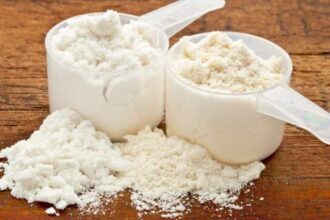One of the most popular grains worldwide is rice. It’s a cornerstone of many cultures’ diets because it’s such a high-quality source of carbs and other nutrients.
Although both brown and white rice are prevalent, there are other colors available. While the two varieties share some common advantages, there are also notable distinctions.
What is Brown Rice?
The rough, inedible outer hull of brown rice is the only part of the grain that is not consumed. The rice’s bran and germ, which are rich in nutrients, are not removed in this process. The bran is the grain’s tough outer covering. The germ of a seed is the embryo and source of nutrition for a new plant to grow from.
The bran and germ are still present in brown rice, making it a very healthy whole grain. It’s a good source of fiber and a number of vitamins and minerals. Brown rice contains many beneficial elements, including:
- Manganese: Supports bone health and metabolism.
- Magnesium: Helps maintain nerve function and bone health.
- Selenium: An important antioxidant that supports immune function.
- Phosphorus: Supports bone health and kidney function.
- Niacin: Converts food into energy and supports skin health.
- Thiamine: Helps convert carbohydrates into energy.
Antioxidants like those found in brown rice’s lignans can help keep cells healthy. Brown rice, as opposed to white rice, has a more chewy texture and a nutty, earthy flavor thanks to the bran.
What is White Rice?
After the bran and germ have been removed from brown rice, all that’s left is the white, starchy endosperm. While this process helps preserve the food, it also eliminates many of the nutrients.
White rice lacks in protein and other nutrients because the bran and germ have been removed during processing. White rice, which has been refined, is fluffier and less flavorful than its chewier brown counterpart.
Some nutrients are lost during the preparation of white rice, hence it is commonly fortified with B vitamins and iron. Overall, the nutritional content of enriched white rice is lower than that of brown rice.
Brown Rice vs White Rice Nutrition
| Nutrient | Brown Rice (1 cup, cooked) | White Rice (1 cup, cooked) |
|---|---|---|
| Calories | 216 | 205 |
| Total Carbohydrates (g) | 44.8 | 45.1 |
| Dietary Fiber (g) | 3.5 | 0.6 |
| Sugars (g) | 0.4 | 0.1 |
| Protein (g) | 5.0 | 4.2 |
| Total Fat (g) | 1.8 | 0.4 |
| Saturated Fat (g) | 0.4 | 0.1 |
| Monounsaturated Fat (g) | 0.4 | 0.1 |
| Polyunsaturated Fat (g) | 0.7 | 0.2 |
| Omega-3 Fatty Acids (g) | 0.1 | 0.0 |
| Omega-6 Fatty Acids (g) | 0.6 | 0.1 |
| Vitamins and Minerals | ||
| Vitamin A (IU) | 0 | 0 |
| Vitamin C (mg) | 0 | 0 |
| Vitamin D (IU) | 0 | 0 |
| Vitamin E (mg) | 0.2 | 0.0 |
| Vitamin K (mcg) | 1.2 | 0.0 |
| Thiamin (B1) (mg) | 0.2 | 0.1 |
| Riboflavin (B2) (mg) | 0.1 | 0.0 |
| Niacin (B3) (mg) | 2.6 | 2.0 |
| Vitamin B6 (mg) | 0.3 | 0.2 |
| Folate (B9) (mcg) | 8.7 | 1.0 |
| Calcium (mg) | 19 | 15 |
| Iron (mg) | 0.8 | 0.7 |
| Magnesium (mg) | 83 | 19 |
| Phosphorus (mg) | 162 | 68 |
| Potassium (mg) | 84 | 55 |
| Sodium (mg) | 10 | 0 |
| Zinc (mg) | 1.2 | 0.6 |
| Copper (mg) | 0.2 | 0.1 |
| Manganese (mg) | 1.8 | 0.7 |
| Selenium (mcg) | 19.1 | 8.2 |
- Fiber – Brown rice has 3.5g of fiber per cooked cup compared to 0.6g in white. The bran provides brown rice with much more fiber, an important nutrient for digestive and heart health.
- Manganese – Brown rice contains over 80% of the recommended daily intake per cooked cup. White rice contains only 25%.
- Magnesium – Brown rice contains 84mg magnesium per cooked cup compared to 19mg in white, providing more of this key mineral.
- Selenium – Brown rice contains 19mcg selenium vs. 7mcg in white rice. The extra selenium in brown rice supports immune function.
- Antioxidants – Brown rice contains far more antioxidants including flavonoids, phenols, and lignans, which help reduce inflammation and oxidative stress.
- Carbs – Both contain similar amounts of total carbohydrates – around 45g per cooked cup. However, brown rice has more nutritious complex carbs compared to more simple carbs in white rice.
Read More: Rice Nutrition Facts: The Staple Grain Packed With Benefits
Brown Rice Glycemic Index vs White Rice
How quickly your blood sugar levels rise after consuming a certain dish can be calculated using the glycemic index (GI). The blood sugar level rises rapidly after eating high GI foods. Foods with a low glycemic index (GI) cause blood sugar to rise more slowly, which is beneficial for people with diabetes and those trying to lose weight.
The glycemic index of brown rice is only 50, making it a low-GI food. A quick flood of glucose into the bloodstream is avoided because to the fiber, fat, and plant components that inhibit its digestion.
When compared, white rice’s glycemic index is a staggering 89. Blood sugar levels surge rapidly because digestion is sped up without the bran and germ. Because of this, brown rice is preferable to white rice when it comes to managing diabetes and can aid in satiety.
Weight Loss Benefits
Brown rice is the best option for those trying to lose weight. Brown rice’s greater fiber content makes you feel full for a longer period of time after eating. This has the potential to prevent day-to-day calorie intake from ballooning.
The energy density of brown rice is lower than that of white rice, hence it has less calories per gram. Brown rice is better for weight control because it allows you to eat more of it without increasing your calorie intake relative to white rice of the same volume.
Brown rice’s low glycemic index also reduces post-meal spikes in blood sugar and insulin, both of which are linked to feelings of hunger.
Brown rice’s complex carbohydrates are digested more slowly than those in white rice, which can lead to less of a spike in blood sugar and a subsequent decrease in satiety.
Related: How Many Calories Are in a Serving of Brown Rice?
Arsenic Concentrations
Arsenic is a poisonous substance that occurs frequently in the environment. When compared to other cereals, rice is particularly adept at soaking up environmental arsenic.
Brown rice has been shown to contain more arsenic than white rice, according to some research. This is because the outer bran layer, which is what is used to manufacture white rice, accumulates the most arsenic.
However, the amount of arsenic in rice varies depending on its place of cultivation. Arsenic levels in rice of any color tend to be lower in places where the land and water contain less of the element. Such places include California, India, and Pakistan.
The arsenic in rice probably won’t harm most people who eat a diversified diet. Pregnant women and young children should still limit their rice consumption to no more than two to three servings per week.
Cooking and Storage
It can take up to 50 percent longer to cook brown rice than white rice. This is due to the fact that the bran layer blocks more water from reaching the starch. If you’re not using a rice cooker, simmer the rice for an extra hour.
Since the oils in brown rice bran go rancid more quickly, white rice is the better option for long-term food preservation. While brown rice only keeps for six months to a year, white rice can be stored for thirty years if done so correctly. The shelf life of rice can be extended by keeping it in a cold, dry place inside an airtight container.
In summary, here are some tips for cooking and storing each type of rice:
- Brown Rice: Soak for 30 minutes or use 1.5 cups water per 1 cup rice. Takes 45-50 minutes to simmer. Store up to 1 year.
- White Rice: Use 1 cup water per 1 cup rice. Takes 15-20 minutes to simmer. Store up to 30 years.
Brown Rice vs White Rice Taste
Brown rice is more substantial than white rice and has a flavor that is more earthy and nutty. It enhances the flavor of foods. White rice’s milder taste and fluffier texture make it ideal for pilafs and for soaking up the flavorful sauces and curries you serve with them.
What makes rice tasty is, in the end, a matter of taste. While many people enjoy brown rice for its robust, nutritious flavor, others find it to be too strong or chewy for their tastes. White rice’s subtle flavor makes it a versatile ingredient. Try a little bit of each kind of rice to see which ones go best with your preferred meals.
Read More: Is Brown Rice Gluten Free? The Definitive Answer
Brown Rice vs White Rice Cost
Generally speaking, brown rice is more expensive than white rice. In contrast to white rice, which must be processed several times to remove the bran and germ, brown rice just has its outer hull removed during processing. This additional work raises production costs and decreases white rice yields.
There is more waste and a need for more efficient storage solutions since brown rice becomes rancid more quickly. Brown rice can be up to two times the price of white rice due to higher production costs. However, brown rice is more cost-effective in terms of nutrients per dollar due to its higher nutritious value.
Should You Switch to Brown Rice?
In moderation, both white and brown rice can be beneficial to your health. Brown rice is a healthier alternative to white rice since it contains more fiber, antioxidants, and vital minerals.
Brown rice is superior to white rice for weight loss and diabetes management because of its higher fiber content, more nutrient density, and lower glycemic index.
Brown rice, on the other hand, still supplies carbohydrates for energy and contains beneficial plant elements like lignans.
Aim to replace at least half of your white rice intake with brown rice for a healthier diet. This makes it possible to enjoy white rice in some meals while getting the extra nutrients you need.
Here are some simple tips for integrating more brown rice into your cooking:
- Use a 50/50 blend of brown and white rice in stir fries or pilafs.
- Make fried rice with brown rice instead of white.
- Use brown rice in sushi rolls or under poke bowls.
- Cook chili or soups over brown rice instead of white.
- Substitute brown rice in any casserole or rice dish.
Brown rice is one of the healthiest grain options due to its greater fiber and vitamin content. To take advantage of the additional nutrients and fiber that brown rice provides, try substituting it for at least some of your weekly rice recipes.
If you like a firmer, chewier grain, simply increase the cooking time accordingly. A little creativity can allow you to easily add extra brown rice to your diet.
- Harvard Health Publishing – Fiber. https://www.health.harvard.edu/staying-healthy/listing_of_vitamins
- MyFoodData – Nutrition Comparison of Brown Rice and White Rice. https://tools.myfooddata.com/nutrition-comparison.php?foods=20060-20064&serv=1c&amt=1&orig=
- FDA – Arsenic in Rice and Rice Products Risk Assessment Report. https://www.fda.gov/files/food/published/Arsenic-in-Rice-and-Rice-Products-Risk-Assessment-Report-PDF.pdf
- Diabetes Care – Glycemic index of foods: a physiological basis for carbohydrate exchange. https://care.diabetesjournals.org/content/4/3/384
- UC Davis – Rancidity of Brown Rice. https://els-jbs-prod-cdn.jbs.elsevierhealth.com/cms/attachment/a4347938-1bb5-4b57-9e41-5988e577b950/gr1_lrg.jpg
- USDA – Full Report (All Nutrients): 20156, Rice, brown, medium-grain, cooked https://fdc.nal.usda.gov/fdc-app.html#/food-details/168567/nutrients








